I look to 2019 with hope and optimism and a strong commitment to improvement in my writing skills, such as they are. Right next to the Chicago Manual of Style on the bookshelf resides Common Errors in English Usage, followed by The Dimwit’s Dictionary, followed by How to Write Funny. Perhaps if I pulled the last up to the front, I can skip the others? In any event, I intend to read them all… certainly before the end of 2019. Promise… Really.
The Browning BPS is proof that a good product will endure. The labels new and revised are always interesting to explore, but think how ideal a product must be to remain in high demand and production for nearly five decades.
A little background so we are not just staring at a picture of a shotgun…
 John Browning’s first pump action shotgun design became the Winchester Model ’93. Designed black powder, 12 gauge 2 5/8″ shells, it was a fragile design at a time when smokeless powder ammunition was rapidly becoming the standard. With a production run of only three years, approximately 34,000 guns were produced, with Winchester buying back and destroying much of what had been sold, to pave the way for the next design.
John Browning’s first pump action shotgun design became the Winchester Model ’93. Designed black powder, 12 gauge 2 5/8″ shells, it was a fragile design at a time when smokeless powder ammunition was rapidly becoming the standard. With a production run of only three years, approximately 34,000 guns were produced, with Winchester buying back and destroying much of what had been sold, to pave the way for the next design.
Browning’s next design, that became the Winchester Model ’97 was an exposed hammer, side eject gun, the biggest improvement over the Model 93 was a more solid topped receiver and a slide/recoil lock that required slight forward movement of the slide before the gun’s breech could be unlocked. The forward motion is automatically provided by recoil, but it prevented a shooter from accidentally pulling back on the slide and unlocking the breech before discharge. The fact that the model remained in production for fifty years, with over a million units sold, suggests these were good ideas.
A refinement came from Browning in a 1904 design became the No. 520 Steven’s repeating shotgun. The design was hammerless, which put a solid receiver between the shooter and the breech bolt, the top of the receiver was further enclosed to place the ejection port fulling on the side and the gun could not be discharged unless the breech was fully closed and locked. The latter, not a minor point. I owned an old Marlin 1898 pump shotgun that could be discharged unlocked, and fragile piece part failure could lock the firing pin forward, which offered entertainment value when chambering a fresh round. Ultimately, while I liked the old gun, I could not live with that much excitement.
The next evolution in design came in 1913, followed with a 1915 Browning patent, and concluding in the form of the the Remington Model 17 with a solid side receiver and bottom load and eject. The Browning BPS product is a derivative of that Browning design. However, the Browning BPS didn’t go into production at Japan’s B.C. Miroku until 1977, a year after Belgium’s Fabrique National acquired the Browning Company from then president John Val Browning. Miroku and Browning had a substantial history based on a substantial financial, technical and product quality investment.
Miroku’s had begun manufacturing an over and under shotgun with John Browning design origins under the Miroku name in 1960. In 1966, under contract with the Browning Company, Miroku began manufacturing Browning’s 22 rimfire lever action rifle, the BL-22. In 1968 a single barrel trap gun, the Browning BT-99 was added. In 1971, both the Browning lever action rifle, the BLR, and the 22 – Semi-auto went online. In 1972 the Browning Side-By-Side and B-78 Single Shot were added. In 1973 a new over and under shotgun, the Citori, was added as a lower cost shotgun than the Browning Superposed which was being manufactured in Belgium.
Browning BPS salient features
The Browning BPS, left, in it’s simplicity, is a beautiful shotgun. Satin finish walnut buttstock and forearm with 18 lines per inch cut ccheckering and matte blue finish forged steel receiver and barrel convey a traditional look. The absence of a side ejection port keep gunk out of the receiver, while bottom load and eject and tang safety make for ease of operation and a naturally ambidextrous configuration.
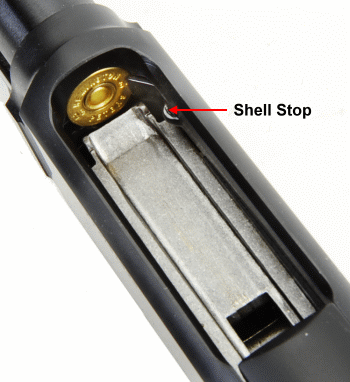
Bottom side – Unobstructed loading. Shell stop permits quick unload without cycling action. Pressing in releases one shell at a time. As received, magazine capacity is two shells for a loaded shotgun capacity of three , as required by federal migratory bird regulations.
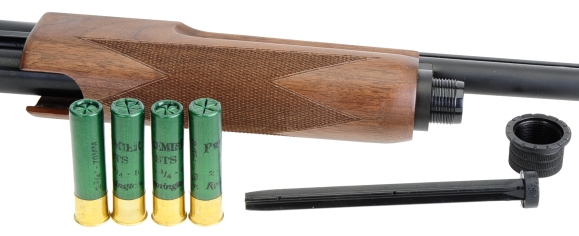
For circumstances other than migratory bird hunting, the three shot plug can be removed for a magazine capacity of four 2 3/4″ shells, five for the shotgun with a loaded chamber. Magazine capacity in gauges other than 28 gauge is four 2 /34″, three 3″ or 3 1/2″ shells. No special tools to use or rapidly expanding magazine springs to dance with; the magazine cap comes off and the capacity limiting adapter pulls out.

Dual steel action bars makes for smooth slide operation and adds strength to the assembly. Yes, there are some exceptional pump shotguns that have a single action bar but, for me, the Browning BPS has a very fluid actuation.
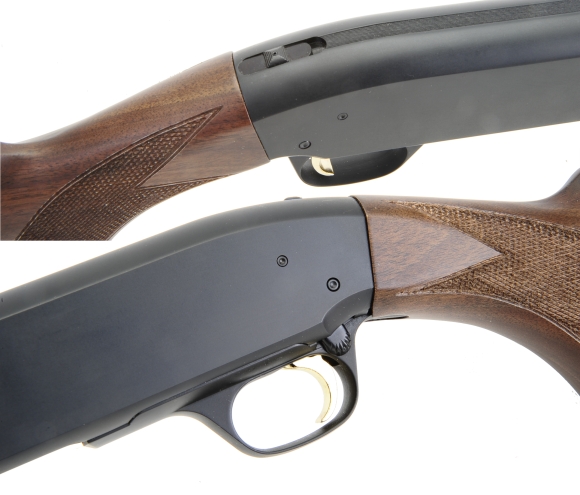
The lack of a side ejection port and only a tang safety and closely cropped slide release button controls make for a very sleek and snag proof exterior.
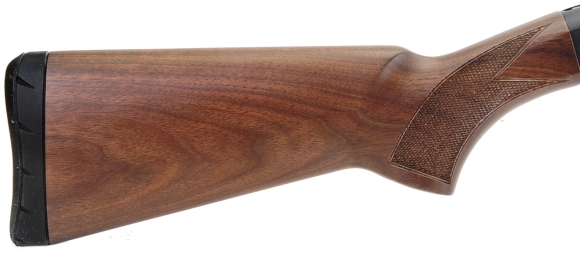
Not that a near seven pound, 28 gauge shotgun needs much of a recoil pad, but the Inflex 1 small recoil pad is a good one. It provides proper length of pull and lateral stability.and it is does not drag when pulling in into a shoulder.
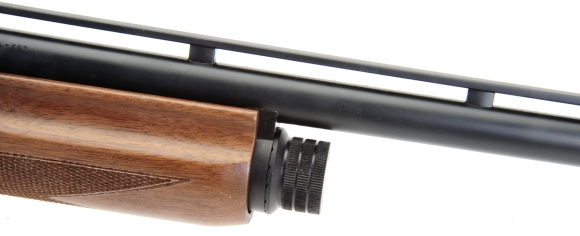
The ventilated rib floats so point is consistent even when the barrel heats up under heavy use. The front sight is a silver colored bead.
| Browning BPS | |
| Item Number | 012284814 |
| Gauge | 28 Ga 2/34″ |
| Barrel Length | 26″ |
| Receiver |
Forged Steel |
| Choke System | Standard Invector |
| Barrel & Receiver Finish | Satin Matte |
| Front Sight | Silver Bead |
| Magazine Capacity | 4 |
| Stock Material | Black Walnut – Grade 1 |
| Stock Finish | Satin |
| Drop at Comb | 1 5/8″ |
| Drop at Heel | 1 7/8″ |
| Length of Pull | 14 1/4″ |
| Overall Length | 46 3/4″ |
| Weight | 6 lbs 15 oz |
| MSRP | $639.99 |
The Browning BPS is currently available in twelve configurations and in .410 bore, 28 GA, 20 GA, 16 GA, 12 GA, and 10 GA within that group. There are wood and synthetic stocked, trap, and hunting versions including a rifled slug gun for sabot slug shooters.
Browning’s Field Grade BPS narrative indicates the shotgun has a matte wood and metal finish, the model spec boxes indicate the finish is satin. I would define it as matte metal finish, but not the matte that looks like black primer. How about semi-matte? Whatever it is, it is a very clean finish that won’t standout while hunting. The stock has a low luster satin finish, which compliments the tight grain, nicely colored walnut.
At only an ounce under seven pounds, the BPS is not a featherweight, but it is well balanced, shoots where it is pointed and tracks comfortably. In 28 gauge, it is easy on the shooter even after spending a good deal of time trying to do serious damage to clay targets.
The stock fit was good for me and my physique; stocky, short legs, long trunk and minimal neck… semi Neanderthal. Truth be told, lobbing off a half inch in pull would have put my shoulder in a more comfortable position. So for most other people, as is should be a perfect fit.
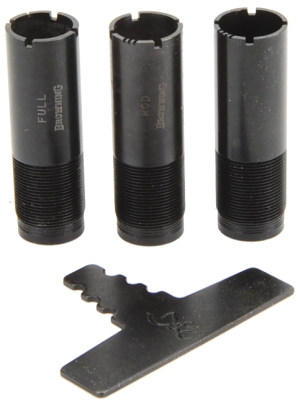
The Browning BPS .410 bore, 28 gauge and 16 gauge and utilizes standard Invector flush chokes. 20 gauge and 12 gauge BPS version utilize the longer Invector Plus system. The BPS is packaged with three chokes: full, modified and improved and a choke tube wrench..
OK, Joe. Why the 28 Gauge and not the 10 Gauge? Really?
Pictured above, L_R, .410 Bore, 28 Gauge, 20 Gauge, 16 Gauge and 12 Gauge. The 10 Gauge is not pictured because it was too big to fit in the frame. Really… Would I lie to you? I stopped shooting 10 Gauge with the advent of back bored guns chambered for 12 Gauge 3 1/2″ shells. That and the fact there are only 14 generally available factory loads for the 10 Gauge and 349 for the 12 Gauge.
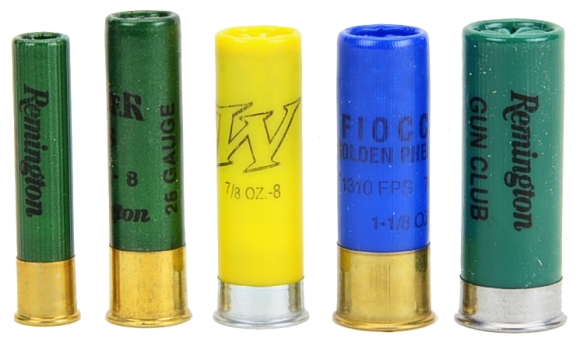
When was the 28 Gauge invented? Who knows. people reference Parker as popularizing the… sorry, had to take a quick break to sing harmony on “Sarah Smile” with Daryl Hall… on Alexa. Some folks think that British 28 Bore is not the same as American 28 Gauge; it is. The 28 Bore shotshell is discussed at length in Greener’s “The Gun and Its Development”, 1881, so it is not a new comer. Within the book, use of the 28 Bore was noted at the 1879 London Field Trials where it seemed to be a recent development, but that is supposition on my part.
The 28 Gauge is perfectly suitable for upland bird hunting and pretty good for rabbit and squirrel hunting. I like the 28 Gauge for skeet. I’ll set up a backyard trap… I live in the Maine boonies, and practice with a 28 Gauge shotgun and full choke. If it has been a while since I have picked up a shotgun, I will embarrass myself through half a box of ammo and then develop a real sense of accomplishment when I start hitting on a regular basis. Recoil with the Browning is negligible, report isn’t even that bad and its easy for others to join in.
Wrapping up before leaving the building…
What can I say? The Browning BPS in 28 Gauge is a lot of fun to shoot and it is relatively easy to shoot well. The action is slick, it feeds and ejects with ease and it proved to be rock solid reliable throughout a week of shooting. Price isn’t at all bad for the quality of the firearm and I suspect it would perform well over the long haul. Something I would like to bring up? Why not.
I’d like to see a lightweight Browning BPS scaled to the 28 Gauge and .410 Bore. Something that weighs in the 5 lb range. Not at all a criticism of this BPS as they would serve two different purposes. Other than me spitballing, the subject BPS is a terrific shotgun with all of the quality enthusiasts have come to expect from Browning.

References:
A History of Browning Guns From 1831 – Browning, 1947
Remington Arms & History – Bill West, 1970
The History of Browning Firearms – Miller
John. M. Browning – American Gunmaker – Browning & Gentry
A Brief History of Browning and the Legendary Miroku Factory – Browning
The American Shotgun – Charles Askins, 1910
The Gun and Its Development – W.W. Greener, 1881

Email Notification